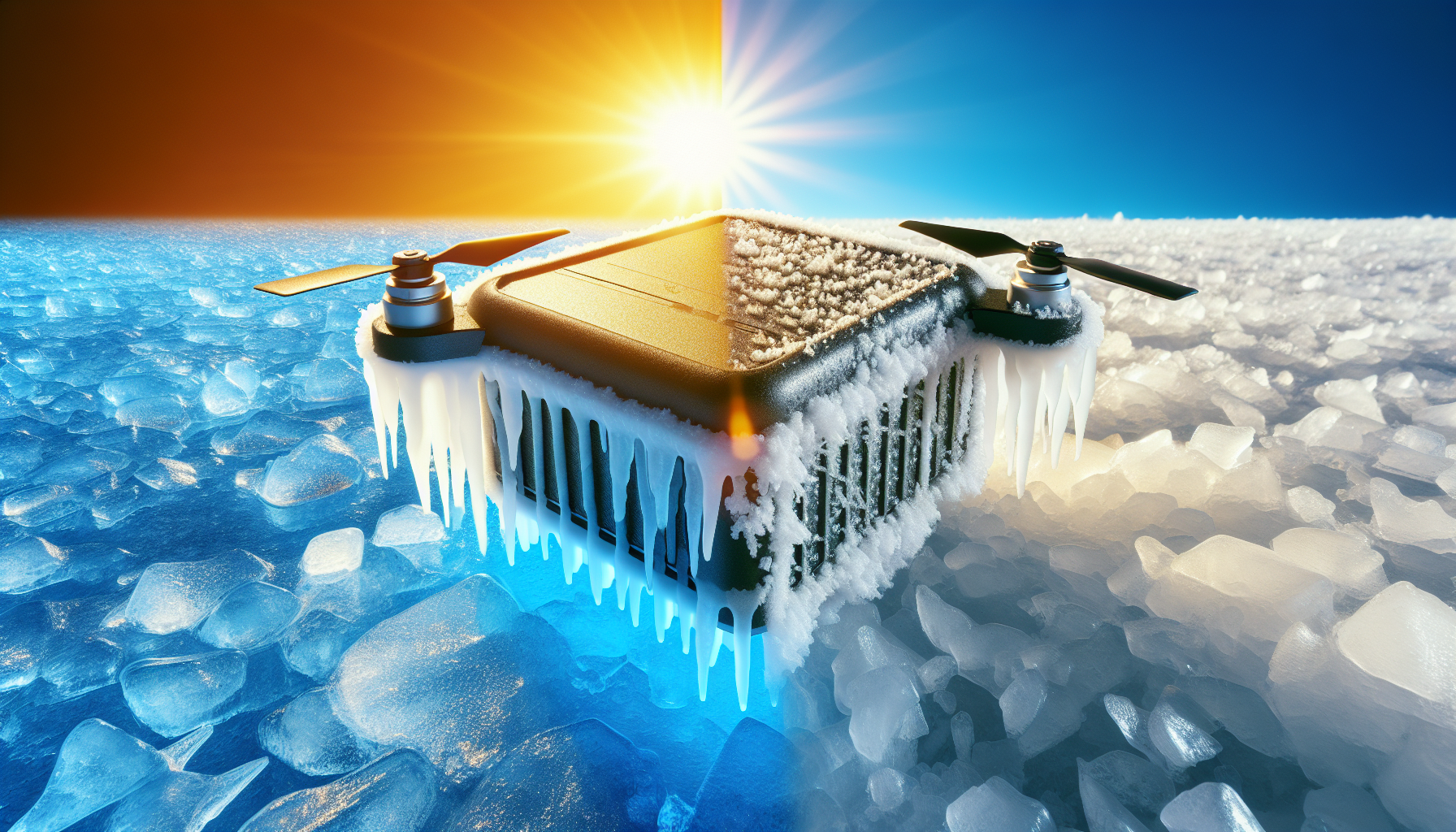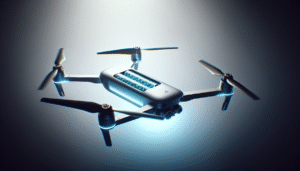Isn’t it curious how something as simple as temperature can have a profound impact on technology? When it comes to drones, a seemingly minor fluctuation in degrees can greatly affect their battery health and performance. If you’re as fascinated by these unmanned aerial vehicles as I am, you’re probably aware that the battery is the heart of the drone. Understanding how temperature plays a role in its functionality can help maximize efficiency and ensure a longer lifespan for the drone.

Understanding Drone Batteries
Let’s start with the basics. Drones are typically powered by lithium-polymer (LiPo) batteries, known for their light weight and high power density. This combination is essential for the agile flight and long-duration capabilities of drones. However, the performance and health of these batteries are significantly influenced by the surrounding temperature.
How LiPo Batteries Work
LiPo batteries function by storing electrical energy in chemical form. Inside the battery, ions move between the anode and cathode, generating a current. While this might sound like a chemistry class throwback, it’s crucial to grasp this to understand why temperature matters.
Common Battery Issues
What happens when your drone battery doesn’t perform as expected? Common issues include reduced flight time, inability to hold a charge, or even swelling. While usage habits contribute, a major underlying factor often ignored is temperature.
The Impact of Cold Temperatures on Drone Batteries
I recall a time I tried flying my drone on a crisp winter morning, full of enthusiasm, only to be met with a frustratingly short flight time. Cold weather can indeed be quite the nemesis for drone enthusiasts.
Reduced Battery Capacity
In cold conditions, LiPo batteries experience a reduced chemical reaction rate. This decreased activity means the battery’s ability to deliver power is compromised, resulting in shorter flight times. Imagine heading out equipped with visions of cinematic aerial footage, only to have your drone land prematurely due to a power drop.
Increased Internal Resistance
Did you ever notice how your phone battery drains faster when it’s cold out? It’s not just your phone; it’s the same for drone batteries. The cold increases internal resistance within the battery, meaning it needs to work harder to deliver power, causing it to deplete more swiftly.
Risk of Damage
Consistently operating in cold temperatures can lead to permanent damage to your drone batteries. Specifically, the risk of internal component damage increases, potentially shortening the overall battery lifespan.

Navigating the Heat: How Hot Temperatures Affect Batteries
On the flip side, have you ever noticed your car engine struggling on an exceptionally hot day? Similarly, high temperatures can take a toll on drone batteries, presenting a host of their own challenges.
Overheating
Heat increases the rate of the chemical reaction within the battery. While this might sound like a good thing, it can lead to overheating if uncontrolled. Overheated batteries can result in reduced performance or, worse, a failure in mid-flight—certainly not the aerial excitement one hopes for.
Reduced Battery Lifespan
Excessive heat can cause the batteries to degrade faster. The wear and tear inflicted by high temperatures actually shorten a battery’s effective life, much like how under duress, we can feel out of sorts much quicker than during ordinary circumstances.
Swelling and Leakage
One unnerving possibility due to high temperatures is battery swelling and leakage. This is when the outer layer of a LiPo battery starts to puff up, often accompanied by the leaking of electrolytes. No drone owner wants to witness such a crisis play out.
Finding the Sweet Spot: Optimal Temperature Ranges
I think you’d agree that maintaining a proper temperature range is key to ensuring peak battery performance. But exactly what temperatures should we aim for?
Ideal Operating Temperatures
Ideally, drone batteries should be operated in a temperature range between 15°C to 25°C (59°F to 77°F). This sweet spot ensures that chemical reactions occur optimally, balancing efficiency and safety. Venturing too far outside this range tends to invite trouble.
| Temperature Range | Battery Impact |
|---|---|
| Below 0°C | Reduced capacity, increased resistance |
| 0°C to 15°C | Sub-optimal performance |
| 15°C to 25°C | Optimal performance |
| 25°C to 35°C | Slightly reduced lifespan |
| Above 35°C | Overheating risk, damage possible |
Pre-flight Preparations
Before you decide to ignite the propellers, acclimatizing the batteries to the ambient temperature is wise. Giving your batteries a bit of a warm-up or cooldown can prevent temperature shock and ensure they’re operating within a safe range.
Practical Tips for Managing Battery Health
By now, you might be wondering how one can manage all these temperature-related issues. Is there a practical strategy to keep the battery strong and in prime condition? Absolutely.
Storage Matters
How you store your drone batteries can significantly impact their health:
- Temperature-Controlled Environment: Store batteries in a cool, dry place, away from direct sunlight or freezing temperatures.
- Partially Charged State: Keeping them at around 40-60% charge capacity helps extend their lifespan when in storage.
Monitoring and Maintenance
Regularly monitor the state of your batteries. Using a battery management system can provide insights into the health and temperature of your battery, ensuring everything is in check.
Pre-flight Warm-Ups
In colder climates, consider lightly warming your batteries before flight. For example, wrapping them in a warm cloth or keeping them in an inner pocket close to your body heat before use can help avoid sudden drops in performance.
Adapting to Extreme Conditions
Even with ideal strategies, one’s geographical location may throw consistent curveballs in the form of extreme temperatures. Overcoming these requires improvisation and adaptability.
Cold Weather
In cold weather conditions:
- Battery Insulation: Use thermal insulation covers or buy insulated battery bags designed to retain heat.
- Short Flights: Opt for shorter, precautionary flights, ensuring the battery retains enough power to return safely.
Hot Weather
For hot climates:
- Shade and Ventilation: Keep drones and batteries out of direct sunlight. Set up a shaded area where equipment can remain cool.
- Cooling Breaks: Allow for regular intervals during flight to let the battery cool down, especially in extended durations.
The Future of Drone Batteries
As technology advances, I’m optimistic about developments on the horizon that might enhance drone battery performance even further. The future holds promise with innovations aimed at resistance to temperature fluctuations and improving longevity.
Innovations in Material
Research into alternative materials and chemical compositions for batteries hopes to create variants more resistant to extremes in temperature.
Enhanced Battery Management Systems
With AI integration and smarter battery management systems, drones are evolving. These systems can actively adjust and optimize performance based on real-time data, taking much guesswork out of the equation.
Conclusion
So, is it any wonder that temperature’s role in drone battery health is so vital? While it’s easy to overlook, understanding and applying temperature management principles can significantly extend battery life and enhance flight performance. As drone enthusiasts and professionals, taking conscientious steps to accommodate temperature variations ensures our drones soar efficiently and remain reliable workhorses.
In the ever-evolving dance between technology and nature, becoming aware of these interactions empowers us to navigate them more adeptly. Whether you’re capturing stunning aerial vistas or delivering parcels with precision, a mindful approach to temperature’s capriciousness ensures your drone adventures are as smooth and successful as possible.


